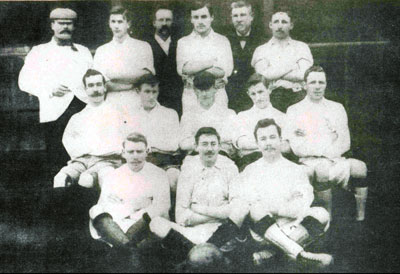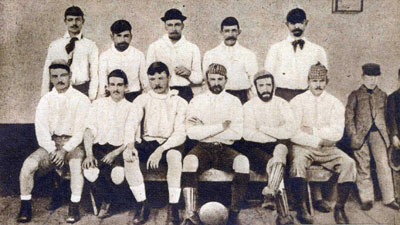|

Alumni, Argentina's First Division
Champion in 1900, including six players from Lobos
Athletic Club. (Standing):
McEwen
(referee), Carlos Carr Brown, Alejandro Watson
Hutton (director of the English High School),
Armando Coste, Diego Brown, and Walter Buchanan.
Seated:
Guillermo Jordan, Tomás Brown,
Andres Mack, Ernesto Brown and Eugenio Moore. (On the
ground): Juan José Moore, Spencer Leonard and
Heriberto Jordan
(Photographer unknown) |
Little has
been documented about the descendants of Irish migrants
and their connection with the introduction of football to
Argentina, a country that is passionate about this sport
to such an extent that it is now a powerful global
competitor. During the last decade of the nineteenth
century, Hiberno-Argentines founded clubs such as Lobos
and Porteño, which competed in the League of Buenos Aires,
the first of its kind in South America. Both clubs have
lasted until the present-day, but they do not identify
themselves with the Irish community of Argentina. This
shift is due to changes in Argentine sport which resulted
in Hiberno-Argentines moving away from football into
different spheres.
Argentina
is recognised world-wide as a force to be reckoned with in
football. One of the factors that might explain this
supremacy is the early development of this sport in the
River Plate when compared with the development of sport in
other parts of the world. Football was regulated
officially in England in 1863, and scarcely four years
later it was already being practiced in Buenos Aires,
where a small group of British residents, including some
Irish people, founded the Buenos Aires Football Club (BAFC),
a pioneer in South America.
But to
what can we attribute this speedy development? The British
colony in Argentina was small and isolated in the main, in
the context of a country in which another language was
spoken. The community strongly felt the urge to recreate
‘ethnic associations’ which could typify the culture of
their country of origin and might serve them in a more
long-term way during their residence in foreign lands. It
is common to hear that football was introduced to
Argentina by 'the English', but in fact the Irish and the
Scottish played a significant part also. Even amongst the
founders of the BAFC in 1867 there was one Dubliner, and
another who hailed originally from County Armagh. Among
the clubs that competed in the first years of the
Association Argentina Football League (AAFL, the first in
South America), founded in 1893, were two clubs founded by
Hiberno-Argentines: Lobos Athletic Club and Porteño
Athletic Club.
Although
this is not the place to elaborate greatly upon the
characteristics of Irish immigration to Argentina, it is
helpful to highlight some pertinent points. The total
number of Irish migrants to Argentina in the nineteenth
century is thought to be 40-45,000 (Murray 2004: 28).
Almost all of these people moved to the province of Buenos
Aires. [1]
Compared with the numbers of migrants who went to North
America, Australia or New Zealand, the number of Irish
migrants who arrived in the River Plate region seems
insignificant. Here however, they arrived at a destination
in which an unfamiliar language was spoken, and though the
Catholic faith was practiced they were immersed in a land
where unfamiliar customs were practiced by entirely
different peoples. This presented challenges to the
possibility of swift integration.
Prior to
the 1840s, the few Irish in Argentina were clustered
mainly in the city of Buenos Aires. From that time,
corresponding to a time of economic crisis in Ireland, an
organised and continuous flow of immigrants began to
increase. In 1844, Father Anthony Fahy arrived, and for
the next three decades he played a fundamental role in the
consolidation and the development of the Irish Catholic
community in Argentina.
From 1870
onwards, the number of migrants diminished significantly,
almost to the point of disappearing. This relates to the
changes which the socio-economic structure of Argentina
underwent at the time. This complicated Irish migrants’
chances of becoming part of the community. Nevertheless,
because of its own organic growth, the community of
Hiberno-Argentines had doubled in number. In the 1890s, an
internal migration began from communities in the
countryside towards the city of Buenos Aires and the other
towns in the province. It was customary at this time for
farmers and landowners to ‘have a house in the city’ and
this coincided with the organisation of the clubs which we
will now analyse.
|

Lobos Athletic Club in 1892.
Standing: Carlos Buchanan (left), J. Braken, José
Garraham, Eduardo Walsh, and M. Braken. Seated:
Gualterio Buchanan, Eduardo Burbridge (Jr.),
Hefferman, Tomás McKeon (with the ball), A. Malcolm,
and Eugenio Seery
(Photographer unknown) |
Football
in the Countryside: Lobos
Work was tough
and distractions few in the immense expanses of the
Pampas. Marriages and wakes were the only forms of
entertainment and social activity for those Irish migrants
who spent most of their days taking care of ewes. As their
income increased, they began to transform their way of
life, sending their children to schools in the city, or to
Britain and Ireland, as well as creating institutions
which improved communication between members of the
community. At the same time, many left rural life and
became part of other sectors of the economy, such as the
railroads. Within this context, the Hiberno-Argentines
began to set up clubs in the region northwest of the
province of Buenos Aires, like the Lobos Athletic Club,
founded in the district of Lobos on 3 July 1892, 102
kilometres from Buenos Aires. In its foundation charter,
the club set out its aims:
Life seems
very dull and monotonous in this town of Lobos and to make
it a little more lively and agreeable a few of the youth
of this place decided upon having some amusement in their
leisure hours on Sunday. This amusement was decided upon
and unanimously namely Association Football. To this
effect a meeting was called and it was arranged to form a
Club which was to be called “Lobos Athletic Club”. |


